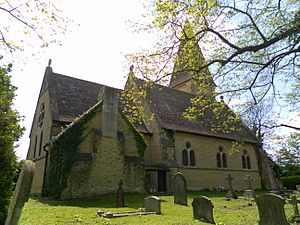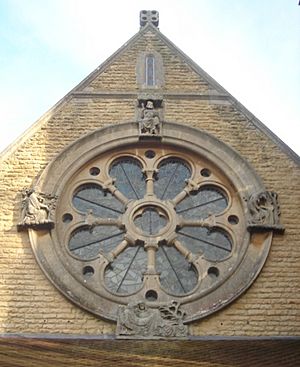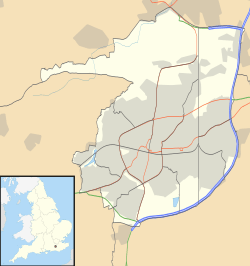St Michael and All Angels Church, Lowfield Heath facts for kids
Quick facts for kids St Michael and All Angels Church |
|
|---|---|

The church from the north
|
|
| 51°8′45″N 0°10′47″W / 51.14583°N 0.17972°W | |
| Location | Church Road, Lowfield Heath, Crawley, West Sussex, RH11 0PQ |
| Country | England |
| Denomination | Seventh-day Adventist |
| Previous denomination | Church of England |
| Website | https://gatwick.adventistchurch.org.uk/ |
| History | |
| Founded | 15 July 1867 |
| Dedicated | 1 December 1868 |
| Architecture | |
| Heritage designation | Listed building – Grade II* |
| Architect(s) | William Burges |
| Style | French Gothic |
| Years built | 1867–1868 |
| Closed | 2004 (reopened 2008 as Horley Seventh-day Adventist Church) |
| Administration | |
| Parish | South England Conference of the Seventh-day Adventist |
| Diocese | Área 4 |
St Michael and All Angels Church is a special church located in a place called Lowfield Heath, near Crawley, West Sussex, England. It was built a long time ago, in 1867, by a famous architect named William Burges. He designed it in a style called Gothic Revival.
This church is very important because it's the only building left from the old village of Lowfield Heath. The village slowly disappeared as London Gatwick Airport grew bigger. The church used to be part of the Church of England. However, the last service there was in 2004. In 2008, it reopened as a Seventh-day Adventist place of worship.
The church building has a special status called Grade II* listed. This means it's a very important building with a lot of history. It's considered nationally important. Today, it stands among modern buildings like warehouses, showing how much the area has changed.
Contents
A Look Back: The Church's History
How Lowfield Heath Village Started
The small community of Lowfield Heath began to grow around 1770. This was when the main road from London to Brighton, the A23 road, became a turnpike. A turnpike road meant people had to pay to use it. This road crossed a wide, open area called a heath. A few farms and houses were built close to this new road.
The heath was once common land, meaning everyone could use it. But in 1827 and 1846, it was enclosed. This meant the land was divided up and owned privately. This change encouraged more people to build homes there. Lowfield Heath then grew into a small village. It had its own school, a public house (a pub), and a post office.
Building the Church
Lowfield Heath village was located right on the border between two counties, Surrey and Sussex. But for church matters, it was part of the Parish of Charlwood in Surrey. A kind merchant donated some land in the middle of the village for a church. This land used to grow damson fruits.
The famous architect William Burges was chosen to design the church. He had worked on big projects like The Great Exhibition in London. He also designed Saint Finbarre's Cathedral in Cork, Ireland. Later, he would build amazing castles like Cardiff Castle and Castell Coch in Wales.
Work on the church began in 1867. The first stone, called the foundation stone, was laid on July 15, 1867. The church was officially opened with a special ceremony on December 1, 1868. This ceremony is called a consecration. Even though the village was small, it did well for the next 80 years. The church was seen as its most beautiful building. Because of its special design, it was given Grade II* listed status on June 21, 1948.
The Village Disappears
In the 1950s, the village of Lowfield Heath started to shrink. This happened because Gatwick Aerodrome was expanded to become London Gatwick Airport. This airport became London's second international airport.
Between the early 1950s and the early 1970s, almost every original building in the village was torn down. Only the church remained. Even the White Lion pub and the last few houses were demolished.
As the nearby town of Crawley grew, the church was moved to the Parish of Crawley. This meant it was now looked after by St John the Baptist's in Crawley. This happened even though the church was still officially in Surrey. However, in 1974, the area became part of the new county of West Sussex. This change meant the church was finally within the Borough of Crawley.
In 1989, a special service was held at the church. It was to remember the village that was lost. A plaque was placed by the entrance door. It says:
In commemoration of a service held in this church at Lowfield Heath on the 30th September 1989 for the occasion of a reunion of those who formed the village community at the outbreak of the Second World War in 1939 and whose homes and village were subsequently displaced by the development of Gatwick International Airport
Church Design and Features

William Burges designed St Michael and All Angels Church in a French Gothic style. This style was popular in the 1200s. The outside of the church is made of small, yellow sandstone blocks. This stone came from a nearby place called St Leonard's Forest. Some Bath Stone was also used for decoration.
The church has a tower at its southwest corner. This tower has a pointed roof called a spire, made of wooden shingles. At the western end, there's a narthex, which is an entrance area. It has a large, round rose window on its west side. Carved pictures around the rose window show the Four Ages of Man.
Inside, the main roofs are very steep. They are made of pine wood in an arch shape. Strong wooden beams, called tie-beams and king posts, hold them up. The arch leading to the main part of the church, called the chancel, is supported by columns. William Burges himself created many of the sculptures and carvings inside. There are also some lovely stained glass windows from the 1800s and 1900s. The east wall has two tall, narrow windows called lancet windows and another small rose window.
The churchyard is also a special place. It contains the war graves of two soldiers from World War I and an officer from the Royal Air Force who died in World War II.
The Church Today
The Church of England stopped using St Michael and All Angels for services in 2004. They then looked for someone else to use the building. In March 2008, a Seventh-day Adventist group was allowed to use it for their worship.
This group, called Horley Seventh-Day Adventist Church, started in May 2005. They were a new church group that grew from an Adventist community in London. They officially became a church in January 2008.
More to Explore
- List of places of worship in Crawley
- Listed buildings in Crawley


